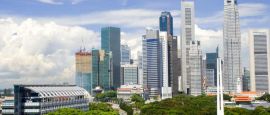Singapore Weather, climate and geography
Weather & climate
Located just north of the equator, Singapore has a tropical climate and stays hot and humid throughout the year. Temperatures average around 31º C (88º F) during the day with little seasonal variation, although it’s slightly cooler in December and January, and hottest in April and May. Temperatures are unlikely to dip below 23º C (74º F) at night; the lowest temperature ever recorded was just over 19º C (66º F).
Singapore receives a considerable amount of rainfall - approximately 2340mm annually. Although there are no distinct wet or dry seasons, the region is affected by two different monsoons. The Northeast Monsoon generally takes place from December to March and is accompanied by more frequent rain, particularly from November to January.
Conversely, the Southwest Monsoon produces a marginally dryer climate from May to September. Despite the slightly lower overall precipitation levels, particularly from June to August, the Southwest Monsoon is characterized by its early-morning rainstorms; these often persist for one or two hours then taper off for the afternoon. Even these drier months experience a fair amount of rain (around 150mm each month), so be prepared for unpredictably wet weather any time of the year.
The beginning and end of the two monsoon seasons are not well defined, but are separated by the shorter inter-monsoon periods of April/May and October/November, during which months afternoon and evening rain showers are likely. These showers are typically sudden and heavy, but often only last for a short time.
The region is extremely humid, with humidity levels usually between 70% and 90%; often the air is muggiest in the early morning, abating somewhat in the afternoon. On rainy days it is not unreasonable to expect the humidity to reach 100%. When visiting, be sure to drink enough water and seek frequent refuge from the sticky heat indoors. March and September are particularly humid and often very uncomfortable.
Thunderstorms are also a very regular phenomenon, occurring on roughly 40% of all days year-round but particularly common during the Southeast Monsoon. In fact, this small city-state has one of the highest rates of lightning activity worldwide.
Despite the unpredictability of the weather, Singapore experiences as much brilliant sunshine as it does rain, and therefore makes for a delightful beach destination. If sunbathing happens to be interrupted by an unexpected shower, there is at least a plethora of indoor entertainment.
As Singapore’s weather does not vary drastically throughout the year, tourism in the area is relatively steady year-round. The weather can be erratic and unpredictable, so it may be best to plan a visit based on the festival season rather than the climate; some of the nation’s most notable are the grand celebrations of Chinese New Year, the Lantern Festival and the Art Festival. Accommodation prices rise significantly during the Formula One racing.
Geography
The island of Singapore is situated off the southern extremity of the Malay Peninsula, separated from the mainland by the Johor Strait which is about 1km (0.8 miles) wide. Causeways run across the strait carrying roads, a railway and water pipes. The main island is mainly flat with only low hills, the highest being Bukit Timah at 166m (545ft). In the northeast of the island, and in the urban district, large areas have been reclaimed, and much of the original jungle and swamp covering the low-lying areas has been cleared. In addition to the main island, the Republic of Singapore includes more than 60 much smaller islands and islets.
Do you have any Feedback about this page?
© 2025 Columbus Travel Media Ltd. All rights reserved. No part of this site may be reproduced without our written permission, click here for information on Columbus Content Solutions.




 You know where
You know where
